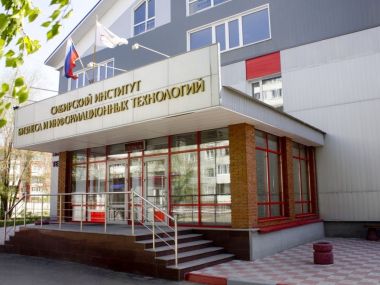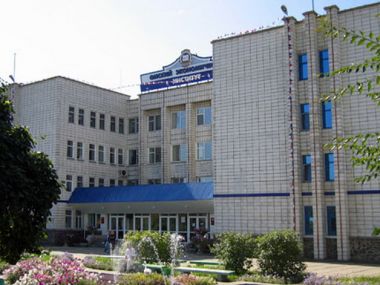
Сибирский институт бизнеса и информационных технологий (CибИТ)Вернуться назад
- Английский языкУчитываются акции и индивид. скидки руб.
Для каждого студента действует персональная система скидок.
Для заказа пиши: менеджеру ВКонтакте, почта, WhatsApp, Telegram, Viber: 8 (983) 524-18-88
GRAMMAR SECTION
Read and translate the text in a written form
State system of the Russian Federation
The Russian Federation is set up by the Constitution of 1993. Under the Constitution Russia is a presidential republic. The federal government consists of three branches: legislative, executive and judicial. Each of them is checked and balanced by the President.
The legislative power is vested in the Federal Assembly. It consists of two chambers. The Upper Chamber is the Council of Federation; the Lower Chamber is the State Duma.
Each chamber is headed by the Speaker. The members of the Federal Assembly are elected by popular vote for a four year period.
Legislature maybe initiated in either of the two Chambers. But to become a law a bill must be approved by both Chambers and signed by the President. The President may veto the bill.
The President is commander in chief of the armed forces; he makes treaties, enforces laws, and appoints ministers to be approved by the Federal Assembly.
The executive power belongs to the Government which is headed by the Prime Minister. The first action of the Prime Minister on appointment is to form the Cabinet.
The judicial branch is represented by the Constitutional Court, the Supreme Court, the Supreme Court of Arbitration, and the regional courts.
The flag of Russia is a tricolor of three equal horizontal fields, white on the top, blue in the middle and red on the bottom. The national anthem of Russia is composed by Alexander Alexandrov. The hymn was adopted in late 2000 by President Vladimir Putin. A new State Emblem of the Russian Federation consists of a black two headed eagle crowned with two imperial crowns, over which the same third crown, enlarged. It is the most ancient symbol of Russia.
All these symbols are official. They have been approved by the Federal Assembly.Exercise 2.
Find the in the text the English equivalents for these words and word combinations. Translate them in a written form:
учредить согласно Конституции; президентская республика; законодательная, исполнительная, судебная власть; система сдержек и противовесов; возложить на;
Федеральное собрание; Совет Федерации; Дума; избирать все общим голосованием; одобрить / подписать закон; наложить вето на законопроект; Верховный Главнокомандующий; назначать министров; возглавлять правительство; Верховный суд; государственный / гимн / флаг / герб.Exercise 3.
Complete these sentences:
1. Under the Constitution Russia is... .
2. The federal government consists of three branches:... .
3. The legislative power is vested in... .
4. The Federal Assembly consists of ... .
5. To become a law a bill must be... .
6. The executive power belongs to … .
7. The judicial branch i s represented by... .
8. State symbols of the Russia n Federation are ... .Exercise 4.
Answer and the following questions. Sum up what you know about the political
system of the Russian Federation. Write a summary.1. What kind of political system does Russia have?
2. I s Russia is a presidential or parliamentary republic?
3. What are the advantage s and disadvantage s of the both forms o f government?
4. What is the highest legislative body of Russia? How is it elected?
5. Who can initiate legislature?
6. What stages must a Bill pass to become a law?
7. What are the President's responsibilities?
8. Who is the head of the executive power? Is the Government elected or
appointed?
9. Which courts is the judicial branch represented by?
10. What are the official symbols of the Russian Federation?English Tenses (Active Voice)
Ex. 1
Combine two simple sentences into a complex one with the subordinate clause of time or condition:
Model: First he’ll gain some experience as a house counsel. Then he’ll start his own practice (when).
– He’ll start his own practice when he gains some experience.1. You must prove the guilt of the suspect. You will win the case. (if)
2. First you must spend two years as an articled clerk. Then you’ll become a solicitor. (after)
3. The attorney will prepare the necessary documents. He’ll send the copy to the client. (as soon as)
4. "Sir, you do not know it to be good or bad. Only the judge can determine it". (till)
5. Please, don’t touch anything. The police will be here in no time. (before)
6. The counsel will not preserve the client’s confidence. He discloses his secrets. (if)
7. He will succeed, I think. He devotes much time to the development of his own practice. (in case)
8. He studies well. His legal education will probably last about five years. (providing)Ex. 2
Use either the Present Continuous or the Present Simple:
1. – I am very busy now. I ______ (to prepare) the documents on a very difficult case.
– ______ (you /to do) it alone?
– No, two managing clerks _____ (to help) me.
2. A solicitor ______ (to deal) with matters outside the court.
3. The Law Society _____ (to regulate) the conduct of solicitors in England.
4. What kind of law (you/to practise)?
5. – What (the attorney/ to do) at present? – He _______ (to study) the particulars of the case.
6. I (not to believe) your evidence! You ______ (to lie)!
7. Legal service costs _______ (to increase) permanently due to inflation.
8. Attorney rarely _______ (to discuss) with their clients the possibility of losing the case.
9. (You/to know) what conveyancing (to mean)? – Conveyancing _______ (to mean) making
all the legal arrangements for the buying and selling of land, houses and other buildings.
10. Probate (to be) a type of work a lawyer _______ (to do) that (to deal) with making a will for a client who, when he/she _______ (to die), _______ (to wish) to leave his/her property to certain persons or charities and making sure that his/her wishes are carried out.
11. The lawyer _____ (to serve) effectively as an advocate only if he ____ (to know) all that his client ____ (to know), concerning the facts of the case.
12. (You/ to know) if the number of lawyers _______ (to increase) or _______ (to decrease) in the country nowadays?Ex. 3
These are Jane’s notes for Monday.
Say, what her plans are, using the Present Continuous:
Model: 9 a.m., Monday. The lecture on criminal law. (attend)
She is attending the lecture on criminal law.
11 a.m. - The pool. (swim)
1 p.m. - Lunch. (to have)
3 p. m. - Preliminary investigation. (to watch)
5 p.m. - Tea with the friends. (to have)
6 p. m. - The seminar on administrative law. (to take part)
8 p. m. - The English language laboratory. (to work)
10 p. m. - Some detective novel. (to read)Ex. 4
Insert the proper forms to express the future actions:
1. The Government has been in the past and _____ in the future a major consumer of legal talent (to be).
2. This argument _____ the judge (not/to convince).
3. I don’t trust this juror. I _____ him (to challenge).
4. He’s a practitioner with long experience. I am sure he ______ the case (to win).
5. Jack is in trouble and needs a legal backing. – I know. I ______ his matter tomorrow (to discuss).
6. I’ve decided to retire from the Federal Agency. – Have you? What _____ you (to do)?
7. Did you send him a summons? – Oh, I’m sorry. I completely forgot. I ____ it now (to do).
8. Can I get your opinion on the case today? – No, you _______ it tomorrow (to get).
9. What you ______ (to do) at 11 tomorrow? – We ______ (to have) a seminar on civil law at this time.ПИСЬМЕННАЯ РАБОТА
Task 1.
Study the structure and content of the business letter below and answer the questions.
NATIONAL ORGANIZATION OF RETIRED PERSONS
Freeport High School, Freeport, Vermont 66622
October 14, 2009
Ms. Iva Stravinsky
Attorney-at-Law
200 Center Street
Freeport, Vermont 66622
Dear Ms. Stravinsky:
Subject: Guest Lecture
The members of the Freeport chapter of the National Organization of Retired Persons would indeed be interested in a lecture on "Proposed Changes in the Financing of Medicare". Therefore, with much appreciation, I accept your offer to address our club.The NORP meets every Tuesday at 8 p.m. in the auditorium of Freeport High School. The programs for our meetings through November 20 have already been established. However, I will call you in a few days to schedule a date for your lecture for the first uesday after the 20th that meets your convenience.
The membership and I look forward to your lecture on a topic so important to us all.
Sincerely yours,
Henry Purcell
President
HP/bm
Notes:
chapter – отделение, филиал организации
retired – удалившийся от дел; вышедший на пенсию
attorney-at-law – лицензированный адвокат
membership – рядовые члены (какой-либо организации)1. What is the name of the company-addresser? Where is it situated? Are any Internet or e-mail details of the company given in the LETTERHEAD?
2. When was the letter prepared?
3. Who is an addressee? What does s/he do? Where does s/he live?
4. Why is the ATTENTION LINE omitted?
5. What does Ms. in a SALUTATION LINE mean?
6. What is the subject of the letter?
7. How many paragraphs are there in a letter?
8. In which paragraph is the reason of the letter formulated? What is it?
9. What details does the second paragraph specify?
10. What information is the letter ended with?
11. What polite expression is used as COMPLIMENTARY CLOSING?
12. Is there COMPANY SIGNATURE in the letter?
13. Who signed the letter? What is his/her title?
14. What do the letters HP/bm in the last line mean?
15. Were any documents enclosed with the letter?
16. Has anyone been sent a copy of the letter?Task 1.
Task 1. Restore the logical order of the parts of a business letter. The first has been done for you.
a) recipient’s name;
b) sender's address;
c) date;
d) complimentary closing;
e) sender's phone;
f) sender' title;
g) sender's e-mail;
h) subject;
i) recipient's title;
j) sender’s signature;
k) recipient's company;
l) enclosures;
m) recipient's address;
n) ATTENTION (department/person);
o) cc;
p) salutation;
q) body of the letter;
r) sender’s name;
s) reference initials.Task 1.
Decide whether the following statements are true (T) or false (F). If you have any doubts, scan Useful
Tips Section which followd to check your answers.1) A business letter is a formal communication between people or companies and it is written to
conduct some sort of business.
2) On unheaded notepaper, you should always write your name above your address.
3) On unheaded notepaper, the address of the sender is on the right.
4) The sender's phone and e-mail are never included in the letterhead.
5) In the UK, the date 2/4/98 means February 4th, 1998.
6) In business letters, dates should appear as numbers separated by full points (.) or obliques (/).
7) The order "day-month-year" (19 October 2005) in indication of date is USA style.
8) The inside address is the recipient's address and it is always on the left margin.
9) The inside address never includes the name of an addressee.
10) Attention line is used when you want a letter to be handled to a specific individual in the company.
11) Subject line is never omitted.
12) You use the salutation Dear Sir or Dear Madam when you know that the person you are writing to is older or more senior than you.
13) If you begin with Dear Sir, you end with Yours faithfully.
14) The initials p.p. indicate that the person signing the letter is doing so on behalf of someone else.
15) It is unusual for the writer to put his/her company position at the end of the letter.
16) The abbreviation Ms can refer to both married and unmarried women.
17) If you are writing to Mrs. Anne Swanson, you open with Dear Anne Swanson.
18) If a colon follows the salutation, a comma should follow the closing.
19) The letters Enc. mean that something else has been sent with the letter.
20) Enc. reminder should appear in the bottom left-hand corner of the page.
21) Lowercase initials are used to indicate the person who typed the letter.
22) In a block format letter, the entire letter is left aligned and single-spaced with double-spacing between paragraphs.
23) In a modified block style, the return address, date, closing and signature start just to the right of the center of the page.Task 2. Translate the Useful Tips section into Russian.
USEFUL TIPS:
- Most companies’ notepapers are headed. However, if you are writing on an unheaded paper, put your address (but not your name) in the top right-hand corner.
- The address of the company you are writing to should appear on the left so that it can be seen through an envelope with a window.
- If you are writing to a specific individual in the company, his/her name and position goes above the address.
- Dates can cause some confusion. 2/3/10 means "the second of March" in English letters, but "February third" in American ones. Confusion may be avoided by writing dates as follows: 2 March (or March 2 in the USA) 2010. The names of the months should not be abbreviated.
- If you do not know the name of the person you are writing to, or you are not sure if you are writing to a man or woman, you should begin Dear Sir or Madam and end Yours faithfully (Yours truly in the USA).
- If you know the person’s surname, begin e.g. Dear Mrs Jones and end Yours sincerely.
- The two styles of punctuation commonly used in business letters are mixed and open. Mixed punctuation requires a colon after the salutation and a comma after the complimentary close. When no punctuation follows Mr or Ms, the salutation and the complimentary close, open punctuation is used.
This style is popular in the UK but it is not considered appropriate in the United States.
- Refer to men as Mr. Refer to women as Ms.[miz], unless in previous correspondence from them they have indicated that they use the title Mrs (for married women) or Miss (for unmarried women).
- When you sign your name, it is common practice to type it out as well and to put your position in the company below it. If someone in a company signs a letter on behalf of someone else, the initials p.p.
(per pro) should be used before the name to indicate this.
- If something is being sent with a letter, Enc. (enclosure) should appear in the bottom left-hand corner of the page.Выполнение письменного задания
Задание 1.
Прочитайте текст и письменно переведите его на русский язык.
Countries export some products and export others because sometimes it is cheaper to buy than to produce. There is warm climate and much vegetation in Australia. This is very good for sheep-breeding, and Australia exports much high quality wool. Taiwan has many skilled technicians and so it produces radios, television sets and other electronic products for export.
Canada’s climate is good for wheat, and Argentina is a low-cost producer of meat. Canada ships its wheat to Argentina and Argentina sells its meat to Canada. Both countries profit by these import-export transactions. Very few countries do not take part in international businessЗадание 2.
Письменно ответьте на вопросы к тексту (на английском языке):
1. Why countries don’t produce some products sometimes but buy them?
2. What does Australia export?
3. What country is a low-cost producer of meat?
4. Why does Taiwan produce electronic products?Задание 3.
Дополните диалог недостающими фразами.
Norman Baker meets John Wiley and Nigel Mc. Can at John’s office.
N. Hello, John. ______________?
J. __________, thanks. ______________?
N. I’m OK. Thank you. Nice weather, isn’t it?
J. _____________. It’s very warm today, isn’t it?
N. Yes, and it’s not so warm back home in Canada.
J. By the way, I want you to meet Nigel Mc Can. He is the head of our sales department.
Nig. __________________. _________________. Is this your first visit to Lincoln?
N. _________, and I enjoy it very much.
J. OK, gentlemen, it’s a quarter past nine. Let’s ___________________. I think we may start with…


